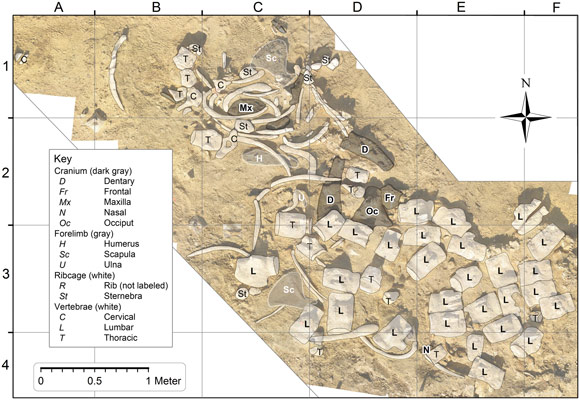Research Confirms Basilosaurus Was a Top Predator
Readers with a long memory might remember an episode from the BBC “Walking with Beasts” television series that first aired in 2001. In this sequel to “Walking with Dinosaurs”, the focus was placed upon the evolution of the mammals after the dinosaur extinction. “Whale Killer”, which was episode two in the six-part series, told the story of a pregnant Basilosaurus (archaic whale), desperately searching for food to help the calf growing inside her. Thanks to raids on Dorudon whales and their young, the Basilosaurus is able to successfully give birth and this episode ends with the mother swimming away with her new-born calf following close behind.
An Illustration of the Fearsome Early Toothed Whale Basilosaurus

Picture credit: Everything Dinosaur
To view models and replicas of marine prehistoric animals: PNSO Age of Dinosaurs.
Analysis of Basilosaurus Stomach Contents
A team of researchers writing in the on-line, academic journal PLOS One, have published the results of stomach content analysis of Basilosaurus specimens from the Late Eocene-aged site at Wadi Al-Hitan in Egypt. It is confirmed that Basilosaurus fed on smaller whales (juvenile Dorudon atrox) as well as large fish (Pycnodus mokattamensis). The scientists, which included Manja Voss (Museum für Naturkunde Berlin) and Mohammed Sameh M. Antar from the Egyptian Environmental Affairs Agency, Cairo, state that this is the first direct evidence of Basilosaurus (B. isis) diet.
A Size Comparison Between an Adult Basilosaurus isis and an Adult Dorudon atrox

Picture credit: PLOS One/University of Michigan
Basilosaurus – Top of a Tethys Ocean Ecological Pyramid
The Late Eocene Epoch was a time of dramatic change and global extinction. The once mighty Tethys Ocean was very much reduced, but the first, giant, toothed whales had evolved and the research team cite Basilosaurus isis, the Late Miocene Livyatan melvillei, and the extant Orca (Orcinus orca) as three marine apex predators known from relatively short intervals of time during the Cenozoic. This research confirms the predator-prey relationship between the two most frequently found fossil whales at the Wadi Al-Hitan location. Bite marks on the preserved skulls of Dorudon whales suggest predation and not scavenging behaviour by Basilosaurus.
A Photomosaic of a Basilosaurus Specimen (WH 10001)
Picture credit: PLOS One
The image above shows a photomosaic of a scattered and disarticulated Basilosaurus isis specimen from the Gehannam Formation of Wadi Al-Hitan. The disarticulation of the fossil skeleton and the scattering suggests disturbance by scavengers and possibly long exposure on the seafloor prior to burial.
The researcher conclude that Basilosaurus was a top apex predator that hunted and ate its prey alive, rather than scavenging for scraps. If the Wadi Al-Hitan site, represents a calving area for the Dorudon, then this would have made an ideal hunting spot for a hungry Basilosaurus. The dramatic scenes in episode two of the “Walking with Beasts” television series, have more published scientific evidence to back up the screenplay.
The Everything Dinosaur website: Everything Dinosaur.







Leave A Comment